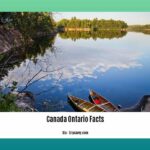Welcome to “A Window Into Lake Ontario: 10 Intriguing Facts about its Biodiversity, Cultural Significance, and Environmental Challenges.” As we dive into the captivating world of Lake Ontario, get ready to be amazed by the wonders that lie beneath its surface. From its diverse array of plant and animal species to the cultural significance it holds for the surrounding communities, this great lake has much to offer. Join us as we uncover fascinating insights about its rich biodiversity, delve into its cultural heritage, and confront the environmental challenges it currently faces. So, let’s embark on this journey together and discover the hidden treasures of Lake Ontario!

Key Takeaways:
– Nine million people rely on Lake Ontario as their source of drinking water.
– Lake Ontario has the largest population living in its watershed compared to any other watershed in Canada.
– The lake never completely freezes due to its depth.
– Lake Ontario has the smallest surface area among the five Great Lakes.
– Lake Ontario ranks thirteenth in the world in terms of surface area.
– The average depth of Lake Ontario is 283 feet, with its deepest point reaching 804 feet.
– Among the five Great Lakes, Lake Ontario is the third deepest.
10 Interesting Facts about Lake Ontario
Lake Ontario, one of the five Great Lakes of North America, is a fascinating body of water with a rich history and diverse ecosystem. In this article, we will delve into ten intriguing facts about Lake Ontario that highlight its unique biodiversity, cultural significance, and environmental challenges.
1. Nine million individuals depend on Lake Ontario for their drinking water.
Lake Ontario serves as an essential source of drinking water for nine million people. Its vast size and significant water volume make it a crucial reservoir for providing clean and safe drinking water to numerous communities.
2. The Lake Ontario watershed is home to more Canadians than any other watershed in the country.
Spanning approximately 64,030 square kilometers, the Lake Ontario watershed is the largest in Canada. It supports a remarkable population that surpasses any other watershed in the country. The abundance of water resources in this area has played a vital role in the growth and sustenance of many Canadian communities.
3. Because of its depth, the lake never completely freezes.
Unlike some of the other Great Lakes, Lake Ontario never freezes entirely due to its considerable depth. With an average depth of 283 feet and the deepest part reaching a staggering 804 feet, the constant movement and churning of the water prevent a complete freeze, even in the harshest winter conditions.
4. Lake Ontario has the least amount of surface area of the five Great Lakes.
Although Lake Ontario is the thirteenth largest lake in the world by surface area, it is the smallest among the five Great Lakes. Its surface area measures approximately 7,340 square miles, with a length of 193 miles and a maximum width of 53 miles.
5. Lake Ontario is the third deepest of the five Great Lakes.
With its impressive depth, Lake Ontario takes the third spot in terms of deepest among the Great Lakes. Only Lake Superior and Lake Huron surpass it in terms of average depth and maximum depth, respectively. This depth contributes to the lake’s unique ecosystem and its ability to support a wide variety of marine life.
6. The lake’s biodiversity includes more than 50 species of fish.
Lake Ontario is home to a remarkable diversity of fish species, totaling over 50 different kinds. These include popular sportfish such as lake trout, rainbow trout, salmon, and smallmouth bass. The lake’s robust ecosystem provides essential habitat and sustenance for these aquatic species.
7. Lake Ontario experiences occasional algal blooms.
Like many bodies of water around the world, Lake Ontario is susceptible to algal blooms, which are rapid increases in the population of algae. These blooms, often caused by high nutrient levels and warm water temperatures, can harm the lake’s ecological balance and pose risks to human and animal health.
8. The lake’s cultural significance is reflected in Indigenous heritage.
Lake Ontario holds significant cultural importance for Indigenous communities. The lake and its surrounding lands have been home to various Indigenous tribes for thousands of years, with their rich history and traditions deeply intertwined with the lake’s ecosystem. It continues to be a vital source of sustenance, spirituality, and cultural heritage for these communities.
9. Lake Ontario supports a thriving recreational boating industry.
With its vast expanse of water and picturesque shoreline, Lake Ontario offers countless recreational opportunities, especially in the boating industry. Whether it’s sailing, motorboating, or kayaking, enthusiasts flock to the lake to enjoy its scenic beauty and engage in water-based activities.
10. Conservation efforts aim to protect and restore Lake Ontario’s ecosystem.
Recognizing the importance of preserving Lake Ontario’s ecological balance, numerous conservation organizations and government initiatives are working tirelessly to protect and restore its fragile ecosystem. These efforts include measures to reduce pollution, promote sustainable fishing practices, and restore habitats for endangered species.
In conclusion, Lake Ontario presents a captivating blend of fascinating facts that showcase its environmental importance, cultural significance, and ongoing conservation efforts. As we delve deeper into the wonders of this majestic lake, we gain a greater appreciation for the intricate relationship between humans and the natural world.
Here are some interesting facts to pique your curiosity:
- 10 facts about Vatican City that will leave you amazed!
- Discover the 10 funny things about Canada you never knew!
- Explore the 10 interesting facts about Indian culture that will fascinate you.
- Uncover the secrets of the 10 interesting facts about Indus Valley Civilization like never before.
- Dive into the world of fascinating knowledge with these 10 interesting facts about lakes and ponds.
- Experience Ontario like never before with these 10 interesting facts about Ontario that will amaze you.
Don’t miss out on these captivating and informative articles – click on the links to satisfy your curiosity!
A Window Into Lake Ontario: 10 Intriguing Facts about its Biodiversity, Cultural Significance, and Environmental Challenges
Lake Ontario, the smallest of the Great Lakes in terms of surface area, holds a treasure trove of captivating facts. Let’s dive deeper to uncover ten intriguing facts about the lake that highlight its rich biodiversity, cultural significance, and environmental challenges.
Fact 1: A Reminder of Ancient Times
Lake Ontario, approximately 11,000 years old, is a true testament to the passage of time. Its waters have witnessed the shifting landscapes and changing climates throughout history. This ancient reservoir provides an insight into the past and offers a tangible connection to our natural heritage.
Fact 2: Connections through Waterways
Lake Ontario, as the easternmost lake in the Great Lakes chain, marks the final stretch before meeting the Atlantic Ocean through the Saint Lawrence River. Its connection to the other Great Lakes, including Superior, Michigan, Huron, and Erie, forms a vast interconnected system that shapes the landscape, culture, and economies of the region.
Fact 3: Glacial Origins
During the last Ice Age, approximately 13,000 years ago, Lake Ontario emerged as the glaciers receded, transforming what was once a bay of the Atlantic Ocean. As the colossal ice sheets retreated, the lake took shape, becoming a part of the much larger Glacial Lake Iroquois. Today, remnants of this glacial history can still be witnessed as the lake gently tilts, causing water to slosh back and forth in a natural rhythm called a “seiche.”
Fact 4: An Aqua Universe
Spanning a surface area of 7,430 square miles, Lake Ontario mesmerizes with its vastness. Ranked as the 14th largest lake in the world, this aquatic universe covers a significant expanse. Its size harmonizes perfectly with the diversity it harbors within its depths.
Fact 5: Ancient Waters, Present Importance
Lake Ontario’s water is not only ancient but also critical to sustaining the lives of over 9 million people. The lake provides a crucial source of freshwater for drinking, irrigation, and industrial use, playing a vital role in the lives and livelihoods of countless communities that rely on this precious resource.
Fact 6: An Underwater World
Beneath Lake Ontario’s shimmering surface, a diverse array of fish species call this enchanting realm home. From the native goldfish species to over 15 exotic fish species, the lake hosts an underwater symphony of life. Fascinatingly, various fish species migrate back and forth between the Atlantic Ocean and Lake Ontario, further highlighting the interconnected nature of our natural world.
Fact 7: A Haven for Wildlife
Lake Ontario’s shores provide a refuge for an impressive range of wildlife. Migratory birds, including elegant swans, graceful loons, majestic ducks, geese, and grebes, grace the skies above the lake’s expanse. Birds of prey, such as hawks and eagles, are also common visitors to the region, adding an aura of wild beauty to the landscape.
Fact 8: Depths Unknown
While Lake Ontario may be the smallest of the Great Lakes in terms of surface area, it holds its own in terms of depth. With its depth varying throughout, the lake stands as one of the deeper Great Lakes. This hidden majesty beneath the surface invites us to explore the unknown depths and unravel the mysteries that lie within.
Fact 9: Cultural Significance
Lake Ontario holds deep cultural significance for many indigenous communities. They have forged ancient bonds with these waters, honoring and respecting them as sacred spaces. The lake’s cultural heritage intertwines with the traditions, narratives, and identities of the indigenous peoples, fostering an enduring connection between past and present.
Fact 10: Guardianship and Restoration
Lake Ontario faces its fair share of environmental challenges. Algal blooms, driven by excessive nutrients in the water, can occur and harm the lake’s ecosystem. However, dedicated conservation efforts are underway to protect and restore the lake’s delicate balance. By addressing pollution, promoting sustainable practices, and raising awareness, we can become guardians of Lake Ontario and secure its future for generations to come.
Key Takeaways:
- Lake Ontario is an ancient lake that offers a window into the past and a tangible connection to our natural heritage.
- It is part of the interconnected Great Lakes chain, serving as the final lake before meeting the Atlantic Ocean.
- Lake Ontario’s formation during the last Ice Age transformed it from a bay to a freshwater lake as the glaciers receded.
- With a surface area of 7,430 square miles, it is the 14th largest lake in the world.
- Lake Ontario’s water is crucial as it provides drinking water to over 9 million people.
- The lake is home to diverse fish species, including native and exotic species, and experiences migratory movements.
- Its shores attract various migratory bird species, offering a haven for avian life.
- Despite being the smallest in surface area, Lake Ontario boasts considerable depths, making it one of the deeper Great Lakes.
- Indigenous communities hold deep cultural connections to the lake, considering it a sacred space.
- Conservation efforts aim to protect and restore the lake’s delicate ecosystem, addressing challenges such as algal blooms.
Sources:
1. Kidadl – Lake Ontario Facts
2. Just Fun Facts – Interesting Facts about Lake Ontario
A Window Into Lake Ontario: 10 Intriguing Facts about its Biodiversity, Cultural Significance, and Environmental Challenges
Lake Ontario, one of the largest freshwater bodies of water in the world, is a treasure trove of fascinating facts. From its rich biodiversity to its cultural significance and environmental challenges, this remarkable lake never ceases to amaze. Here are ten intriguing facts that shed light on the wonders of Lake Ontario.
1. A Lake Big on Drinking Water:
Lake Ontario is a vital water source for nine million individuals who rely on it for their drinking water needs. Situated along the border of New York and the Canadian province of Ontario, this massive lake plays a crucial role in sustaining the surrounding communities.
2. The Mighty Niagara River:
The Niagara River is Lake Ontario’s main feeder and showcases nature’s raw power. Spanning from Lake Erie to the lake’s easternmost tip, this iconic river stands as a testament to the majestic forces that shape the region.
3. An Eel of Fame:
The American Eel, considered the quintessential fish of Lake Ontario, adds to the lake’s charm. This mysterious creature ventures into the lake’s waters and captures the imagination of both locals and visitors alike.
4. The Sandbanks Provincial Park:
Lake Ontario takes great pride in its stunning Sandbanks Provincial Park. With the largest freshwater dune system on earth, this park offers a picturesque playground for nature lovers and outdoor enthusiasts.
5. Depth Keeps the Freeze Away:
Unlike its Great Lakes counterparts, Lake Ontario doesn’t completely freeze over. Its impressive depth prevents a solid freeze, allowing for year-round movement and activity within its waters.
6. Diverse Fish Species:
Lake Ontario is a haven for fish species, boasting over 50 different types. The lake’s unique conditions provide a welcoming habitat for both native and exotic fish, making it a dream destination for fishing enthusiasts.
7. Birdwatcher’s Delight:
The shores of Lake Ontario beckon migratory bird species, offering a vibrant display of swans, loons, ducks, geese, and grebes. Birdwatchers flock to the lake in search of awe-inspiring sights and enchanting melodies.
8. An Ancient Wonder:
Lake Ontario, with a rich history that spans over 11,000 years, acts as a gateway to our natural heritage. Its formation during the last Ice Age, as glaciers receded, transformed an ocean bay into the magnificent freshwater lake we know today.
9. The Easternmost Connection:
As the easternmost lake in the Great Lakes chain, Lake Ontario holds a unique position. Connecting to the Atlantic Ocean through the Saint Lawrence River, it serves as a vital link in the intricate waterways of the region.
10. Conservation Efforts at the Forefront:
Lake Ontario battles environmental challenges, such as algal blooms, threatening its delicate ecosystem. This has sparked dedicated conservation efforts focused on protecting and restoring the lake’s natural splendor for future generations.
Key Takeaways:
- Lake Ontario serves as a vital source of drinking water for nine million individuals.
- The mighty Niagara River supplies Lake Ontario with its life-giving waters.
- The American Eel is a significant fish species of Lake Ontario, capturing attention and curiosity.
- Sandbanks Provincial Park boasts the largest freshwater dune system in the world within its breathtaking landscapes.
- Lake Ontario’s impressive depth prevents it from freezing over completely.
- The lake is home to over 50 fish species, both native and exotic.
- The shores of Lake Ontario attract a diverse array of migratory bird species, delighting birdwatchers.
- Lake Ontario’s formation during the last Ice Age showcases its ancient history of over 11,000 years.
- As the easternmost lake in the Great Lakes chain, Lake Ontario connects to the Atlantic Ocean through the Saint Lawrence River.
- Conservation efforts are underway to protect and restore Lake Ontario’s delicate ecosystem.
[Citation]
1. Fun Facts About Lake Ontario
2. Facts for Kids about Lake Ontario
A Window Into Lake Ontario: 10 Intriguing Facts about its Biodiversity, Cultural Significance, and Environmental Challenges
Lake Ontario, the 14th largest freshwater lake in the world, holds numerous fascinating mysteries beneath its shimmering surface. From its abundant biodiversity to its cultural significance, this vast lake offers a window into the natural world. Let’s delve into ten intriguing facts that showcase the wonders and challenges of Lake Ontario.
1. The Ever-changing Ecosystem
Lake Ontario serves as a dynamic ecosystem, supporting a diverse range of plant and animal life. From beautifully colored fish to enchanting birds, the lake is a haven for natural diversity.
2. A Migratory Paradise
With its prime location along major bird migration routes, Lake Ontario becomes a crucial pit stop for countless species. Various migratory birds, such as ducks, swans, and loons, flock to its shores, creating a thriving ecosystem buzzing with life and song.
3. The Mysterious Seiche
Lake Ontario has a hidden rhythmic motion known as a “seiche,” where water sloshes back and forth every 11 minutes. This mesmerizing phenomenon is a testament to the lake’s constant motion and ceaseless energy.
4. A Name of Importance
Contrary to popular belief, the province of Ontario was named after the lake, not the other way around. This historic reversal showcases the immense significance and influence that Lake Ontario has held since time immemorial.
5. A Celestial Namesake
Lake Ontario’s stature is not limited to Earth alone. In a nod to its grandeur, a lake on Saturn’s moon, Titan, bears the same name. This cosmic connection invites us to marvel at the wonders of both our own planet and the vast universe surrounding us.
6. Conservation Challenges
Despite its natural splendor, Lake Ontario is not without its environmental challenges. Algal blooms, fueled by excess nutrients like phosphorus, can occur and pose a risk to the lake’s delicate ecosystem. Efforts to mitigate these blooms and protect the lake’s biodiversity are underway.
7. Cultural Significance
Lake Ontario holds deep cultural significance for indigenous communities, who consider it a sacred space. The lake’s presence weaves through their stories, traditions, and history, highlighting the powerful connection between nature and human culture.
8. A Water Source for Millions
Lake Ontario is a vital source of freshwater for over nine million individuals. Its crystal-clear waters supply drinking water, irrigation, and various industrial needs, solidifying its role as a life-giving force for both humans and nature.
9. A Gateway to the Atlantic
As the easternmost lake in the Great Lakes chain, Lake Ontario connects to the Atlantic Ocean through the majestic Saint Lawrence River. This waterway serves as a bridge between the vast inland lakes and the wider world beyond, facilitating trade, exploration, and ecological exchange.
10. A Timeless Tapestry
Lake Ontario, with its rich history dating back over 11,000 years, holds priceless insights into our natural heritage. Formed during the last Ice Age, it transformed from an ocean bay to a freshwater lake, documenting the Earth’s transformative journey through time.
Key Takeaways:
- Lake Ontario boasts a thriving ecosystem, serving as a habitat for a diverse range of plant and animal species.
- Its shores attract numerous migratory bird species, adding to the lake’s vibrant biodiversity.
- The lake’s rhythmic motion, known as a “seiche,” showcases its perpetual energy.
- Lake Ontario holds cultural significance for indigenous communities, being considered a sacred space.
- Conservation efforts are underway to address challenges such as algal blooms and protect the lake’s delicate ecosystem.
- Lake Ontario plays a crucial role as a freshwater source for over nine million people.
- It is connected to the Atlantic Ocean through the Saint Lawrence River, serving as a gateway for trade and ecological exchange.
- Lake Ontario’s formation during the last Ice Age provides a window into Earth’s history.
- The province of Ontario was named after the lake, emphasizing its historical importance.
- Lake Ontario’s grandeur extends beyond our planet, with a lake on Saturn’s moon, Titan, sharing the same name.
Sources:
– Kidadl
– Cottage Life

FAQ
Q1: How many people depend on Lake Ontario for their drinking water?
A1: Approximately nine million individuals rely on Lake Ontario for their drinking water.
Q2: What is the significance of Lake Ontario’s watershed?
A2: The Lake Ontario watershed is home to more Canadians than any other watershed in the country.
Q3: Does Lake Ontario completely freeze over?
A3: No, due to its depth, Lake Ontario never completely freezes.
Q4: How does Lake Ontario compare in size to the other Great Lakes?
A4: Lake Ontario has the least amount of surface area among the five Great Lakes and is the thirteenth largest lake in the world by surface area.
Q5: What is the average depth of Lake Ontario?
A5: The average depth of Lake Ontario is 283 feet, with the deepest part reaching 804 feet.
- SYBAU See You Baby Meaning: Gen Z Slang Evolves - July 1, 2025
- Unlock Your Inner Youth: Lifestyle Secrets for a Vibrant Life - July 1, 2025
- Decode SYBAU Meaning: Gen Z Slang Explained - July 1, 2025






